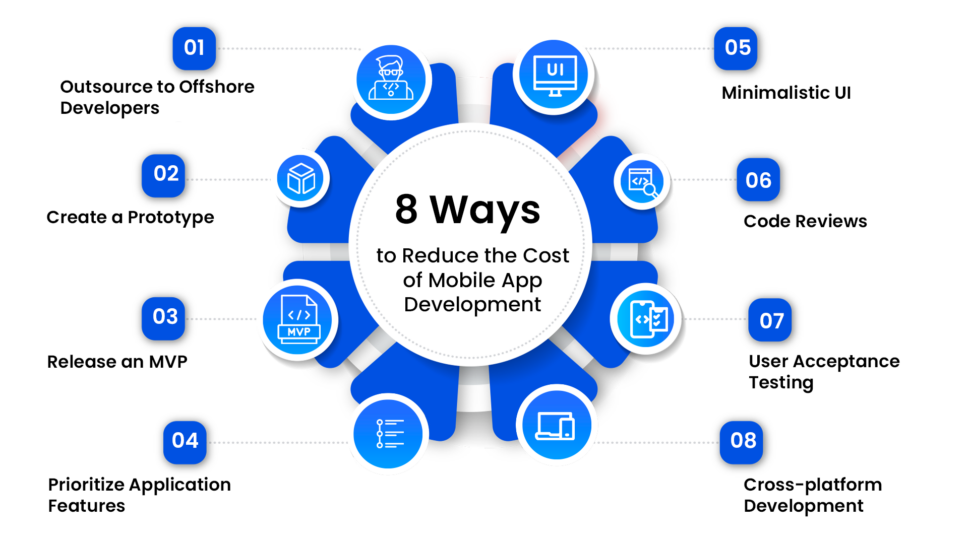There is a constant rise in innovation in the mobile app space. Right from new-gen technology integration to the advent of never-heard-before app ideas like scan and shop apps to buy now pay later, the industry is up for newness. These cutting-edge offerings, however, often come packed with a high cost of application development.
While you would have heard that the easiest way to reduce the cost of mobile app development is outsourcing development to offshore developers from India, there are other methods to lower app development costs as well like building MVP with prioritized app features, minimalistic UI, cross-platform development, code reviews, and user acceptance testing.
Incorporating these methods into the app development process is necessary to survive the rising prices in the industry. While these are only surface-level approaches, there are a number of other ways you can lower the cost of mobile app development – one we will be discussing in detail here.
8 Ways to Reduce Cost of Mobile App Development
Managing your app development budget well and ensuring better app product quality are not always possible simultaneously. Therefore, you must find ways to increase the value of your product while lowering app development costs.

8 Ways to Reduce Cost of Mobile App Development
- Outsource to Offshore Developers
- Create a Prototype
- Release an MVP
- Prioritize Application Features
- Minimalistic UI
- Code Reviews
- User Acceptance Testing
- Cross-platform Development
1. Outsource to Offshore Developers
Outsourcing offshore developers from countries like India for better development prices can be a great starting point for entrepreneurs with limited budgets. The reason for this is the difference in the economy of countries, which can lead to a reduction in costs due to currency conversion. For example, if you pay $100,000 for a standard app development service in the USA, you will only pay $45,000 to $65,000 for the same by hiring experienced offshore developers from India, Ukraine, or Romania.
On top of that, India is one of the top countries rising through its reliable IT and software development solutions. It enables you to acquire quality development solutions at prices much more beneficial for your budget than the average cost of app development in your country. Whether you are a startup or a large business, you must spend limited money on a project that has equal chances of failure as it has of success.
Outsourcing to offshore developers from India allows you lower development costs while preventing an unrecoverable waste of money, time, and effort.
2. Create a Prototype
A prototype is a mockup of your mobile app with interactive elements like simulated functionalities and screens. It allows you to analyze the application feasibility in the market with inputs from stakeholders, clients, target users, and the whole team.
A prototype helps understand the user journey better and identifies the flaws in the interface or experience, and the lack of user-friendly features. In short, it enables the development team to identify ineffective factors and elements in the process and application itself, saving costs by eliminating problems that delay development and deployment while improving the overall application user interface/experience, before the app development process begins.
3. Release an MVP
An MVP (Minimum Viable Product) is a version of your app with a simple user interface and only the core features and functionalities. It takes less time and costs to build, helping you test your application better by deploying it for use by end users. At the same time, you can also begin to generate revenue from your app. Industry experts recommend it for app development projects with a limited budget and multiple goals.
Do the market research, determine the core features, choose a simple yet appealing interface design, and build the MVP application. It will help you save costs on development while helping you improve the application with insightful feedback directly from target users.
4. Prioritize Application Features
Building features in applications like location tracking, biometric authentication, or AI-based dashboards can take a lot of time, effort, and APIs, all of which can significantly increase the development cost. Although many such features can be crucial inside an application, they might not be in yours.
You must prioritize the features required for the core functionality of your mobile app and remove all that your app does not need to provide value to target users. It will help you cut costs on APIs, development hours, reviews, and feedback implementations.
5. Minimalistic UI
Like an MVP, a minimalistic user interface has only the core elements of your app presented through the most easy-to-find functionalities and highly appealing use of the color combination. Such user interface design is quickly becoming famous among target app users such as millennials and GenZ.
The beneficial element of this interface design is the decreased development time and costs. Due to creatively simple design requirements, a minimalist approach to UI can lower costs while keeping up with the latest trend in user interface design.
6. Code Reviews
In a team of developers, code reviews are an approach that requires every developer to check and evaluate the coding work of another after a cycle. For instance, if a developer completes the coding work on a particular feature/functionality, any other developer in the team can check and evaluate the coding work to ensure its effectiveness and identify any inconsistencies/errors.
It helps you prevent multiple functionality errors that arise during testing or even after deployment, increasing the development time and costs.
7. User Acceptance Testing
User acceptance testing is a manual application testing method that includes target users to test the application interface and experience from their perspective. It allows you to identify and remove any elements in your app that would lead to instant uninstallation and bad reviews. Since the application is tested directly by end users, the results tell you exactly where your app needs improvement and deal with any bugs/errors.
It can help you save additional costs to deal with user interface and experience issues after deployment. More importantly, it enables you to build a user-centric mobile app that meets all the expectations and needs of your target users.
8. Cross-platform Development
Cross-platform development is an approach to app development that allows you to build an app compatible with multiple operating systems like iOS, Android, and Windows. It includes a single reusable code that developers can use to develop the same app for several operating systems, saving hours of development and reducing costs.
Building a separate native app for every operating system can be a long-term and costly commitment. On average, the average cost of app development for a native app ranges from $75,000 to 120,000, and you will need to build that for all operating systems. Building cross-platform will cost you $40,000 to $62,000 for an app you can make for multiple operating systems. It is one of the easiest ways to save costs on mobile app development.
Conclusion
Reducing the cost of mobile app development solely depends on your development approach, UI/UX design, and the location of developers. Choose cross-platform development, a minimalistic UI design, and outsource to an offshore app development company to lower app development costs without compromising the final product quality.
Even better if you can find a one-stop solution offshore development company since they will take care of everything from research and planning to development and maintenance, all at affordable prices.
Frequently Asked Questions
Analyze the app requirements carefully, build a prototype, create an MVP, choose a minimalistic UI design, and outsource to offshore developers.
The best ways to reduce the cost of mobile app development are by choosing cross-platform development, building a prototype and an MVP, and outsourcing to an offshore development company.
User acceptance testing, code reviews, prototype, and an MVP app are some KPI methods that you can use to reduce app development costs.
The cost of app development entirely depends on your business goals, developers, UI/UX design, development strategy, number and type of features, and the location of the developers. The average standard app development costs range from $35,000 to $62,000 for a standard version, $20,000 to $25,000 for an MVP app, and $90,000 to $150,000 for an advanced app.




















.png)
.png)
.png)



Leave a Comment